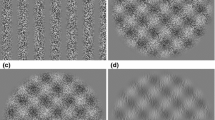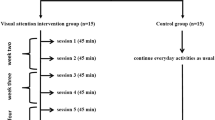Abstract
Older adults tend to overestimate their step-over ability. However, it is unclear as to whether this is caused by inaccurate self-estimation of physical ability or inaccurate perception of height. We, therefore, measured both visual height perception ability and self-estimation of step-over ability among young and older adults. Forty-seven older and 16 young adults performed a height perception test (HPT) and a step-over test (SOT). Participants visually judged the height of vertical bars from distances of 7 and 1 m away in the HPT, then self-estimated and, subsequently, actually performed a step-over action in the SOT. The results showed no significant difference between young and older adults in visual height perception. In the SOT, young adults tended to underestimate their step-over ability, whereas older adults either overestimated their abilities or underestimated them to a lesser extent than did the young adults. Moreover, visual height perception was not correlated with the self-estimation of step-over ability in both young and older adults. These results suggest that the self-overestimation of step-over ability which appeared in some healthy older adults may not be caused by the nature of visual height perception, but by other factor(s), such as the likely age-related nature of self-estimation of physical ability, per se.







Similar content being viewed by others
References
Alexander, N. B. (1996). Gait disorders in older adults. Journal of the American Geriatrics Society, 44(4), 434–451.
Backus, B. T., Fleet, D. J., Parker, A. J., & Heeger, D. J. (2001). Human cortical activity correlates with stereoscopic depth perception. Journal of Neurophysiology, 86(4), 2054–2068.
Bhalla, M., & Proffitt, D. R. (1999). Visual-motor recalibration in geographical slant perception. Journal of Experimental Psychology: Human Perception and Performance, 25(4), 1076–1096.
Butler, A. A., Lord, S. R., & Fitzpatrick, R. C. (2011). Reach distance but not judgment error is associated with falls in older people. Journals of Gerontology. Series A Biological Sciences and Medical Sciences, 66(8), 896–903.
Butler, A. A., Lord, S. R., Taylor, J. L., & Fitzpatrick, R. C. (2015). Ability versus hazard: Risk-taking and falls in older people. Journals of Gerontology. Series A Biological Sciences and Medical Sciences, 70(5), 628–634. doi:10.1093/gerona/glu201.
Elliott, D. B., Vale, A., Whitaker, D., & Buckley, J. G. (2009). Does my step look big in this? A visual illusion leads to safer stepping behaviour. PLoS One, 4(2), e4577. doi:10.1371/journal.pone.0004577.
Gabbard, C., Cacola, P., & Cordova, A. (2011). Is there an advanced aging effect on the ability to mentally represent action? Archives of Gerontology and Geriatrics, 53(2), 206–209.
Gibson, J. J. (1958). Visually controlled locomotion and visual orientation in animals. British Journal of Psychology, 49(3), 182–194.
Gibson, J. J. (1979). The ecological approach to visual perception (New edition ed.). New York: Psychology Press.
Hedden, T., & Gabrieli, J. D. (2004). Insights into the ageing mind: A view from cognitive neuroscience. Nature Reviews Neuroscience, 5(2), 87–96. doi:10.1038/nrn1323.
Iwami, T., Nishida, Y., Hayashi, O., Kimura, M., Sakai, M., Kani, K., et al. (2002). Common neural processing regions for dynamic and static stereopsis in human parieto-occipital cortices. Neuroscience Letters, 327(1), 29–32.
Kallman, D. A., Plato, C. C., & Tobin, J. D. (1990). The role of muscle loss in the age-related decline of grip strength: Cross-sectional and longitudinal perspectives. Journal of Gerontology, 45(3), M82–M88.
Kwee, I. L., Fujii, Y., Matsuzawa, H., & Nakada, T. (1999). Perceptual processing of stereopsis in humans: High-field (3.0 T) functional MRI study. Neurology, 53(7), 1599–1601.
Lindenberger, U., & Mayr, U. (2014). Cognitive aging: Is there a dark side to environmental support? Trends Cognitive Sciences, 18(1), 7–15. doi:10.1016/j.tics.2013.10.006.
Nishida, Y., Hayashi, O., Iwami, T., Kimura, M., Kani, K., Ito, R., et al. (2001). Stereopsis-processing regions in the human parieto-occipital cortex. Neuroreport, 12(10), 2259–2263.
Owsley, C. (2011). Aging and vision. Vision Research, 51(13), 1610–1622. doi:10.1016/j.visres.2010.10.020.
Pierscionek, B. K. (1996). Aging changes in the optical elements of the eye. Journal of Biomedical Optics, 1(2), 147–156. doi:10.1117/12.230729.
Raz, N., Gunning-Dixon, F., Head, D., Rodrigue, K. M., Williamson, A., & Acker, J. D. (2004). Aging, sexual dimorphism, and hemispheric asymmetry of the cerebral cortex: Replicability of regional differences in volume. Neurobiology of Aging, 25(3), 377–396. doi:10.1016/s0197-4580(03)00118-0.
Raz, N., Rodrigue, K. M., Kennedy, K. M., Head, D., Gunning-Dixon, F., & Acker, J. D. (2003). Differential aging of the human striatum: Longitudinal evidence AJNR. American Journal of Neuroradiology, 24(9), 1849–1856.
Resnick, S. M., Pham, D. L., Kraut, M. A., Zonderman, A. B., & Davatzikos, C. (2003). Longitudinal magnetic resonance imaging studies of older adults: A shrinking brain. Journal of Neuroscience, 23(8), 3295–3301.
Rhea, C. K., Rietdyk, S., & Haddad, J. M. (2010). Locomotor adaptation versus perceptual adaptation when stepping over an obstacle with a height illusion. PLoS One, 5(7), e11544. doi:10.1371/journal.pone.0011544.
Robinovitch, S. N., & Cronin, T. (1999). Perception of postural limits in elderly nursing home and day care participants. The Journal of Gerontology A Biology Sciences and Medical Sciences, 54(3), B124–B130. (discussion B131).
Sakurai, R., Fujiwara, Y., Ishihara, M., Higuchi, T., Uchida, H., & Imanaka, K. (2013). Age-related self-overestimation of step-over ability in healthy older adults and its relationship to fall risk. BMC Geriatrics, 13, 44.
Sakurai, R., Fujiwara, Y., Sakuma, N., Suzuki, H., Ishihara, M., Higuchi, T., et al. (2014). Influential factors affecting age-related self-overestimation of step-over ability: Focusing on frequency of going outdoors and executive function. Archives of Gerontology and Geriatrics, 59(3), 577–583. doi:10.1016/j.archger.2014.07.017.
Schillings, A. M., Mulder, T., & Duysens, J. (2005). Stumbling over obstacles in older adults compared to young adults. Journal of Neurophysiology, 94(2), 1158–1168. doi:10.1152/jn.00396.2004.
Sugovic, M., & Witt, J. K. (2013). An older view on distance perception: Older adults perceive walkable extents as farther. Experimental Brain Research, 226(3), 383–391. doi:10.1007/s00221-013-3447-y.
Wood, J. M., Lacherez, P. F., & Anstey, K. J. (2013). Not all older adults have insight into their driving abilities: Evidence from an on-road assessment and implications for policy. Journals of Gerontology. Series A Biological Sciences and Medical Sciences, 68(5), 559–566. doi:10.1093/gerona/gls150.
Wraga, M. (1999). Using eye height in different postures to scale the heights of objects. Journal of Experimental Psychology: Human Perception and Performance, 25(2), 518–530.
Acknowledgments
This study was supported by a Grant-in-Aid for JSPS fellows (23-5365). The authors acknowledge Dr. Mami Kokuho of Sophia University for her support. We also gratefully acknowledge Naoko Sakuma of the Tokyo Metropolitan Institute of Gerontology for her valuable suggestion.
Author information
Authors and Affiliations
Corresponding authors
Ethics declarations
Conflict of interest
The authors declare that they have no conflicts of interest.
Ethical approval
The research protocol was approved by the Tokyo Metropolitan Institute of Gerontology.
Informed consent
All participants gave informed consent prior to their inclusion in the study.
Rights and permissions
About this article
Cite this article
Sakurai, R., Fujiwara, Y., Ishihara, M. et al. Self-estimation of physical ability in stepping over an obstacle is not mediated by visual height perception: a comparison between young and older adults. Psychological Research 81, 740–749 (2017). https://doi.org/10.1007/s00426-016-0779-9
Received:
Accepted:
Published:
Issue Date:
DOI: https://doi.org/10.1007/s00426-016-0779-9




